Sannō Site, Tagajō City, Miyagi Prefecture
Features going back to an ancient city
Sannō is a settlement site south of Taga castle, the northernmost base of the ritsuryō state.
Excavation was conducted in the Hachiman district in Fiscal Year 2012, in conjunction with the construction of the Sanriku coastal expressway (a Great East Japan Earthquake reconstruction project) that will cut lengthwise north-south through the site. There were new discoveries for the Middle Kofun (first half, fifth century) and Late Kofun (first half, seventh century) periods.
An elite residence compound from the first half of the fifth century
Three pit structures from the first half of the fifth century were discovered. Together with those previously excavated, the total comes to 28. Among these were buildings where the most advanced technology of the day, smithing, was conducted. The eastern side was surrounded by a fence and a large ditch, the northern side faced on to the river, and from the rubbish dump in the river items used by the elite were found, such as a cane made with deer antler and a decoration for a sword. As the image presented by these finds differs from that of ordinary villages, they are thought to represent an elite residence compound, where those of power lived and from where they ruled.
A shell midden from the first half of the seventh century
A shell midden was found in the remains of a river from the first half of the seventh century, running through the middle of the village. The main component was oyster, and in addition to pottery and objects made of clay and stone, there were wooden implements and items fashioned from bone and antler, plus animal bones and so forth recovered in large numbers. Excavations of shell middens for this period are few in number even on a nationwide scale, and it proved to be an important discovery for learning what people were eating and other aspects of the village at the time.
Also, there was a concentration of pit structures, with the total regarded as exceeding 100 buildings. As locally produced Sue ware is plentiful, and among other things there are lacquer items made in imitation of Buddhist paraphernalia, this is thought to have been a large village exemplary of the Sendai plain.
An important discovery for considering the origins of Taga castle
That a fifth-century elite residence compound and a large seventh-century village were maintained in the vicinity of Taga castle shows there was an economic base in the northeast portion of the Sendai plain for supporting these during the Kofun period. This can be called an important finding for considering the origins of Taga castle. (Murata Kōichi)
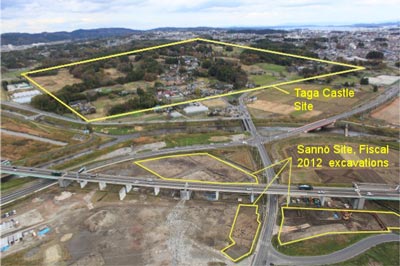 View of the environs of the investigation area An aerial view of the investigation area in the Hachiman district, from the southwest. The remains of Taga castle stand atop a hill on the other side of the river, and to the right at back is Shiogama bay.
Adapted from Hakkutsu sareta Nihon rettō 2013 [Excavations in the Japanese Archipelago, 2013] (Bunkachō [Agency for Cultural Affairs], ed., Asahi Shimbun Publications, 2013).
|

Tuyere (bellows nozzle) A tube made of clay that connected a bellows for blowing air, and a furnace for smelting metal. Tuyeres of the first half of the fifth century were the leg portions of Haji ware pedestaled dishes that were reutilized. Length: 9 cm; width: 6 cm. |

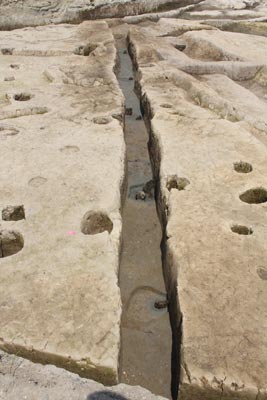
Fence enclosing an elite residence compound (right) and a pit structure within the compound (left) On the eastern side of the compound a fence and a large ditch, separated 3.2 m east-west, extended more that 70 m north-south. The fence had round or square pillars about 20 cm in size, set up at intervals of 2.5–3.0 m in a ditch. The large ditch was 4.4 m wide and 1.1 m deep. The investigated pit structures were 7 m square east-west by north-south, with 4 pillars supporting the roof. | |
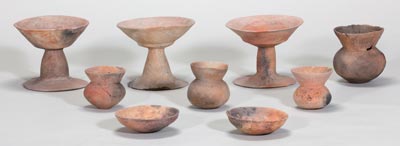
Tableware of the first half of the fifth century The tableware of this period is characterized by plates being few in number, while red-painted pedestaled dishes with long legs and vases were plentiful. The vase on the far right of the back row is 13 cm in both height and width. |
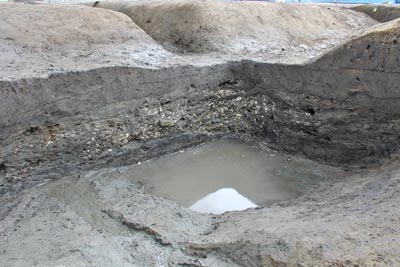
Buried river This river of the first half of the seventh century was 9 m wide and about 1.5 m deep. Near the river bottom was a layer of shell (shell midden) about 40 cm thick. Wooden implements and items made of bone and antler, plus animal bones and shells, not seen at other sites, were recovered in large numbers. |

Knife handle with an incised design A square design has been incised in two tiers, upper and lower, using an implement with a sharp tip. Length: 13 cm; diameter: 2 cm. Made from deer antler.
Adapted from Hakkutsu sareta Nihon rettō 2013 [Excavations in the Japanese Archipelago, 2013] (Bunkachō [Agency for Cultural Affairs], ed., Asahi Shimbun Publications, 2013).
|
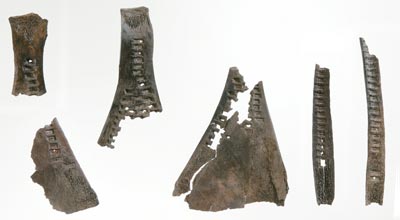
Bones used in divination Shoulder blades and rib bones (the two items at right) were used. After being worked into thin pieces, series of shallow rectangular grooves were carved out. The bottoms of the grooves were then burned with an implement in the shape of a cross, and the fortunes of events or the success of the yearfs harvest were divined from the manner in which the bones cracked. The oracle bone at center is 11 cm long and 9 cm wide. |

Pottery of the first half of the seventh century The first four rows are tableware, with characteristically blackened interiors. Behind are jars used for cooking and storage. Third from the left on the back row, the long-bodied jar has a greatest diameter of 18 cm, and a height of 30 cm. | |
